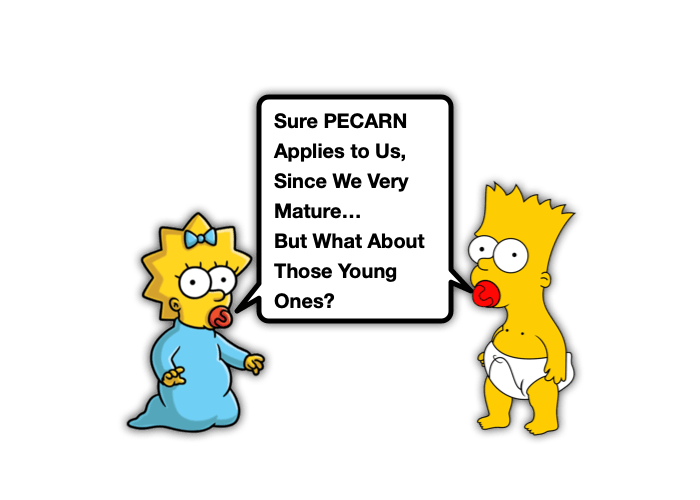Closed Head Injury – PECARN for < 3 Months: Rebaked Morsel

We all know that Gravity Works! While this fact can adversely affect anyone, it offers the greatest challenge for those who cannot protect themselves, like children less than 3 months of age! We last pondered this in 2011 Morsel, just a couple years after PECARN head injury data was published. Since that time there have been several studies externally validating the PECARN rule in all age groups and in multiple different countries. More recently there has been a focus on the application of this rule in the under 3 month group. If you are a frequent user of MDCalc like myself, you may have noticed the annotation to apply with caution in under 3 months was removed in the last year. So, it would seem that now is an opportune time for a Rebaked Morsel on Closed Head Injury and the application of PECARN for children less than 3 months of age.
Closed Head Injury – PECARN for under 3 months
What are the special concerns in the < 3 month group?
- They are an incredibly vulnerable population
- You are entirely reliant on parent’s history of what happened, and this may not be the truth.
- Always look out for other signs of NAT including bruising, evidence of prior trauma, frequent visits for similar incidents [Ide, 2017].
- They are more challenging to examine and obtain a neurologic exam – the 3-month-old is just starting to reliably track objects (Milestones matter).
- They have thinner bones of the skull which makes them more prone to skull fractures.
- Infants who fell from a parent’s arms, especially those who were dropped on stairs or fell from infant products have the highest risk of abnormal head CT including skull fractures [Burrows, 2015]
PECARN Head Injury Data and patients < 3 months of age
As a reminder, the under 3 month group is included in the under 2 y/o PECARN guidelines [Kupperman, 2009]:
- CT if change in mental status, GCS < 15, or palpable skull fracture
- Observe vs CT using shared decision making if LOC > 5 sec, non-frontal hematoma, severe mechanism, or not acting normally per parent
So what has changed in the last 14 years?
- PECARN is highly sensitive for identifying those with clinically important TBI. However it was not as sensitive in age < 3 months for any TBI on CT or for any skull fracture on CT [Abid, 2021]
- A secondary analysis of the original PECARN data set focused on < 3 months of age with MINOR blunt head trauma.There were just over 1,000 children < 3 months in the original data set
- 514 met the PECARN low-risk criteria, and 58.6% of these had a CT performed
- 1 (0.2%) had a clinically important TBI (ciTBI)
- 10 (5.1%) had any TBI on CT
- 9 (4.6%) had skull fractures
- Remember to always watch out for NAT!
- One external validation study showed an improvement in sensitivity of the PECARN rule when cases of NAT were removed indicating that PECARN is less sensitive in cases of NAT [Ide, 2017].
- Clinical judgement continues to be important in addition to correctly applying the clinical guidelines
- An additional study showed PECARN prediction rules were significantly more sensitive (100% vs 60%) in preverbal children as compared to clinical judgement. However clinical judgement was more specific in this same group (54% vs 92%) [Atabaki, 2016] .
- When we discussed this topic previously, we concluded with “Clinical Guidelines are never perfect, but this one is pretty good”. That remains the same, but hopefully this new information adds some additional knowledge for your own clinical judgment.
Moral of the Morsel
- Gravity Works on all ages! It is good to have an plan for how you will evaluate the children who are more challenging to evaluate after closed head injury (those < 3 months of age).
- PECARN Works too! While no guideline is perfect, the PECARN < 2 year old category for closed head injury is useful for children < 3 months of age.
- Clinical Judgement is also important! Chat GPT hasn’t replaced us … yet.
References:
Abid Z, Kuppermann N, Tancredi DJ, Dayan PS. Risk of Traumatic Brain Injuries in Infants Younger than 3 Months With Minor Blunt Head Trauma. Ann Emerg Med. 2021 Sep;78(3):321-330.e1. doi: 10.1016/j.annemergmed.2021.04.015. Epub 2021 Jun 17. PMID: 34148662.
Atabaki SM, Hoyle JD Jr, Schunk JE, Monroe DJ, Alpern ER, Quayle KS, Glass TF, Badawy MK, Miskin M, Schalick WO, Dayan PS, Holmes JF, Kuppermann N. Comparison of Prediction Rules and Clinician Suspicion for Identifying Children With Clinically Important Brain Injuries After Blunt Head Trauma. Acad Emerg Med. 2016 May;23(5):566-75. doi: 10.1111/acem.12923. Epub 2016 Apr 20. PMID: 26825755.
Burrows P, Trefan L, Houston R, Hughes J, Pearson G, Edwards RJ, Hyde P, Maconochie I, Parslow RC, Kemp AM. Head injury from falls in children younger than 6 years of age. Arch Dis Child. 2015 Nov;100(11):1032-7. doi: 10.1136/archdischild-2014-307119. Epub 2015 Aug 21. PMID: 26297697; PMCID: PMC4680174.
Ide K, Uematsu S, Tetsuhara K, Yoshimura S, Kato T, Kobayashi T. External Validation of the PECARN Head Trauma Prediction Rules in Japan. Acad Emerg Med. 2017 Mar;24(3):308-314. doi: 10.1111/acem.13129. PMID: 27862642.
Kuppermann N, Holmes JF, Dayan PS, Hoyle JD Jr, Atabaki SM, Holubkov R, Nadel FM, Monroe D, Stanley RM, Borgialli DA, Badawy MK, Schunk JE, Quayle KS, Mahajan P, Lichenstein R, Lillis KA, Tunik MG, Jacobs ES, Callahan JM, Gorelick MH, Glass TF, Lee LK, Bachman MC, Cooper A, Powell EC, Gerardi MJ, Melville KA, Muizelaar JP, Wisner DH, Zuspan SJ, Dean JM, Wootton-Gorges SL; Pediatric Emergency Care Applied Research Network (PECARN). Identification of children at very low risk of clinically-important brain injuries after head trauma: a prospective cohort study. Lancet. 2009 Oct 3;374(9696):1160-70. doi: 10.1016/S0140-6736(09)61558-0. Epub 2009 Sep 14. Erratum in: Lancet. 2014 Jan 25;383(9914):308. PMID: 19758692.

